Introduction
Fertilization plays a critical role in tomato production across the state of Florida. However, appropriate fertilization management depends on four major components (4Rs): the right fertilizer source applied at the right rate and the right timing in the right placement for a crop. Farming practices that follow the 4Rs can provide nutrients for optimal tomato productivity while minimizing the risk of nutrient losses and adverse environmental effects, both of which are important to the development of agricultural sustainability.
The 4Rs were developed by the International Plant Nutrition Institute in the interest of the nutrient efficacy and sustainability of agriculture (IPNI 2013). The implementation of 4R nutrient stewardship not only can improve the productivity of the agricultural industry, but the efficient investment of fertilizers can also promote social, human, and physical capital.
The 4Rs of fertilizer management (Hochmuth et al. 2022) and the description of 4R nutrient stewardship (Liu et al. 2019) recently published on EDIS can provide a general guideline for implementation in crop production. However, the components of 4Rs are crop-specific and site related. Tomato is a high value crop grown across the whole state of Florida. This publication is for growers, Extension agents, statewide specialists, and graduate students implementing the 4Rs in Florida tomato production. It is worthwhile to mention that the implementation of Tomato Good Agriculture Practices (T-GAPs) and Tomato Best Management Practices (T-BMPs) is mandatory in the state of Florida (FDACS 2012). All tomato growers and handlers, regardless of variety or production system, must follow the guidelines, such as cultivation, field management, harvest, transportation, packing, and handling operations, through the entire production process.
Right Source
Several factors, such as product characteristics, delivery methods, product price, economic constraints, and environmental concerns, determine the right source of fertilizers. The scarcity of plant-available nutrients in most Florida soils with either high (calcareous soil) or low pH values (acidic soil) constrains crop normal growth and development, which are critically important for the right source selection and a balance adjustment. For example, when conventional nitrogen fertilizer is applied to calcareous soil with pH as high as 8.2, especially in Miami-Dade County, volatilization may occur immediately and strongly limit nitrogen efficiency. However, controlled-release or slow-release fertilizers coated with elemental sulfur or polymers can reduce the volatilization loss dramatically.
In addition to soil characteristics, farming practices also determine the right sources of fertilizer. For instance, plasticulture on raised beds with drip irrigation system is almost exclusively practiced for the commercial production of tomatoes in Florida. In this regard, there are typically three sources of fertilizer considerably applicable to tomato crops: conventional dry fertilizers, controlled-release or slow-release fertilizers, and liquid fertilizers.
Conventional Dry Source Fertilizers
Combined fertilizers containing nitrogen (N), phosphorus (P), potassium (K), and some micronutrients including iron (Fe), zinc (Zn), and copper (Cu) are usually applied as basal dressing before setting the layout of plastic mulch and driplines (Figure 1). Soil fumigation with Telone (except for Miami-Dade County), K-PAM, V-PAM, or Dominus is also applied for pest control right before covering the beds with plastic mulches. The common formulas of combined or mixed fertilizer can be 8-16-16, 10-10-10, 6-6-12 or 12-12-12 (N-P2O5-K2O in percentage, same as following) for pre-plant application (Figure 2).
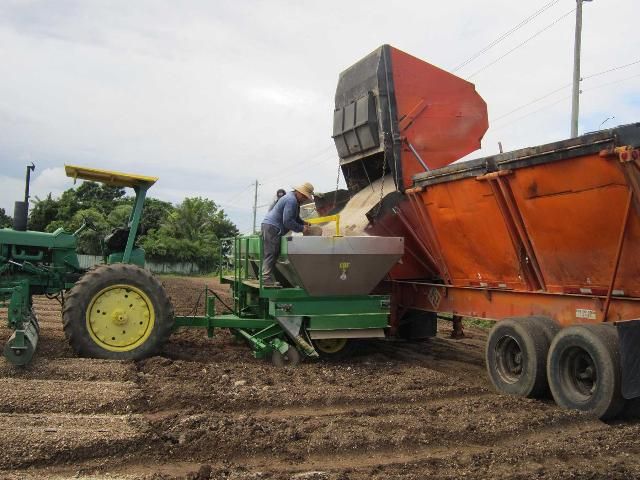
Credit: Qingren Wang, UF/IFAS
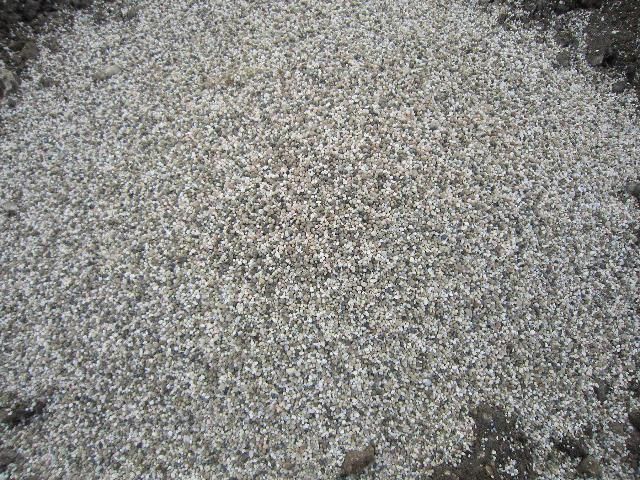
Credit: Qingren Wang, UF/IFAS
Controlled-Release or Slow-Release Source Fertilizers
Controlled release fertilizers (CRFs) have an advantage over conventional dry fertilizers because they can be applied at a relatively higher rate during the basal application and reduce the application frequency. CRFs can release nutrients in certain patterns to meet crop needs (Liu et al. 2014). In such a case, it is important to develop an appropriate source of CRF that is specifically for tomato crops, in which nutrient release rates and timing synchronize with nutrient requirements during different stages of growth and development of tomato plants. Currently, there have been several CRFs available on the market, such as sulfur-coated urea with 30–40% N, polymer/resin-coated fertilizer with 18–44% N, polymer sulfur hybrid coated urea with 37–43% N, and combined fertilizers with 16-6-13 (Figure 3). The current price for CRF is about 2-3 times higher than conventional fertilizers. To reduce the cost and meet plants' immediate needs, most tomato growers prefer to mix CRF with conventional fertilizers in basal dressing for tomato crops.

Credit: Qingren Wang, UF/IFAS
Liquid Source Fertilizers
To provide a successive supply of nutrients to tomato crops, a liquid source with N and K2O at 4-0-8 or 3-0-10 (Figure 4) is commonly applied with the irrigation driplines (fertigation). The liquid source is essential for meeting the tomato requirement for N and K during the fruiting stage. The determination of liquid type, application rate, and starting time for the liquid fertilizer depends on the fertilizer sources applied at the pre-plant stage, and liquid fertilizer can provide plant nutrient needs more quickly and efficiently than conventional dry fertilizers or CRF.
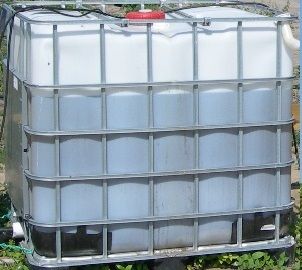
Credit: Advanced Citrus Production Systems, UF/IFAS
Right Rate
The appropriate rate depends on the fertilizer source and application time, which should coordinate well with the crop requirement for various nutrients. For instance, tomato plants need more phosphorus during the seedling stage but need more nitrogen and potassium during the vegetative and fruiting stages. Likewise, CRF can be applied at a greater rate than conventional sources can because it can stay in the soil longer and the nutrients release gradually to meet plants need.
The total recommendation rates for tomatoes through the growing season in Florida are 200 lb N and 120–150 lb each of P2O5 and K2O per acre. With conventional sources, the pre-plant rate with the corresponding fertilizer formulas typically varies from 60 to 80 lbs per acre based on the content of pure nitrogen, for instance, 600–800 lbs per acre for the formula 10-10-10 or 1,000–1,300 lbs per acre for the formula 6-6-12 (Figure 5).
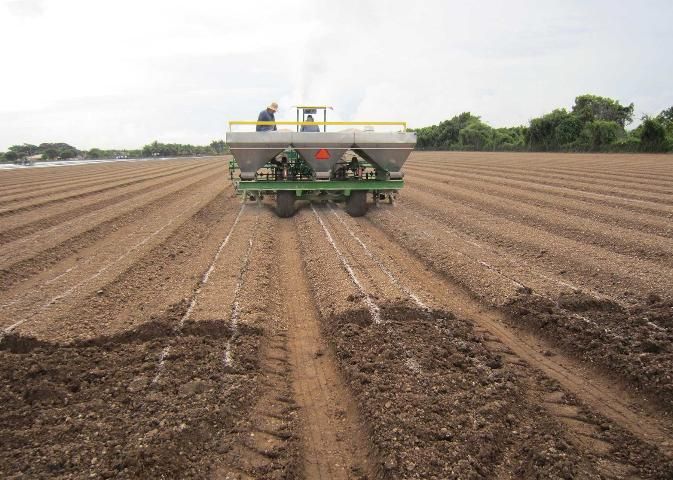
Credit: Qingren Wang, UF/IFAS
The ratio of N:P2O5:K2O is another important factor in meeting the plants' needs. Tomato does not need the ratio of 1:1:1 of N:P2O5:K2O at all times during its life cycles. However, sufficient supply of P and K during the early stage is needed by tomato plants, and it is essentially important for establishment.
With CRFs, about 1/2 to 2/3 of the total amount of fertilizer can be applied as basal dressing, i.e., pre-plant application, and the rest can be applied with fertigation. For instance, with CRFs, up to 100 to 150 lb N per acre, which equals to 625 to 938 lbs per acre of 16-6-13, can be applied as the pre-plant application rate. If CRF is mixed with conventional fertilizer, the correspondent contents of N in different sources should be considered for the total amount. More importantly, the CRF coated with polymer contains N, P, and K, which is superior to sulfur-coated urea because the latter contains N only and P and K fertilizers have to be applied separately from N.
After the conventional fertilizer has been applied at pre-plant stage, approximately 2.0 lb pure N per acre each day is needed during the flowering or fruiting stage for optimal growth and development of tomatoes. If CRF was applied at the pre-plant stage, the liquid fertilizer rate can be reduced to 1 to 1.5 lb pure N per acre depending on the pre-plant rate applied. The optimal rate of liquid fertilizer depends on the crop status, target yield, varieties or cultivars, soil fertility, irrigation rate, frequency, and pest management. The fertigation rate depends on the pressure, the hose, and the opening of the valve, so calibration is needed prior to the application to deliver the target rate of liquid fertilizers.
Right Timing
Timing according to the stage in a plant's life cycle is another critical factor for the optimal function and efficacy of fertilizers. For instance, tomato seedlings do not need a lot of N (Figure 6). On the contrary, too much N can burn the plants and cause nutrient loss through leaching and volatilization. However, at their early stage, tomato plants need a lot of P for their normal growth and establishment. For almost every annual crop, from seedling to reproductive stages, plants usually take up a substantial amount of P and utilize it in the life cycle, and plants also need K in a relatively constant pattern for their normal growth and development. However, plants need to take up more N during the vigorously vegetative and fruiting stages rather than the early stage (Figure 7).
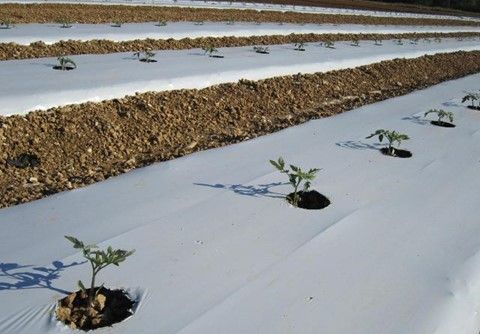
Credit: Qingren Wang, UF/IFAS
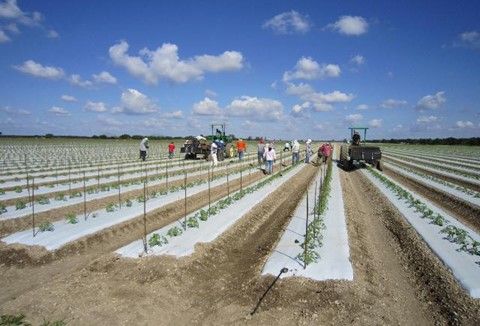
Credit: Qingren Wang, UF/IFAS
With conventional fertilizers, pre-plant application of sufficient rates of P and K is essential because the threshold period of most vegetable crops for P requirement is during the early development stage. Though the seedling establishment stage needs a certain amount of N for normal growth and development, the delicate seedlings can be easily burnt or damaged by the overdose of conventional N fertilizer.
Compared to conventional fertilizers, when CRFs are applied, the release curve is a top consideration when deciding the timing for side-dressing, but it usually can be delayed. Currently, some CRFs used for vegetable crops contain all major nutrients, N, P, and K, which has the advantage of providing a full recipe to tomato plants; when sulfur coated urea is used, conventional P and K fertilizers are still needed and are either mixed with the sulfur coated urea or separately applied. Based on previous, unpublished field trial results, when P and K are included in CRF, such as the polymer coated formula 16-6-13 (Figure 3), the application of such CRF to sweet corn and green beans can provide all their nutrients needed. Additional application of P and K is unnecessary.
As tomato plants grow larger, more N and K are needed (Figure 8). The blooming stage of tomatoes in South Florida starts about 6 weeks after transplanting. From the blooming stage to harvest (Figure 9), more nutrients and water are needed as compared to the early stage. Fertigation with the required rate (1.0–2.0 lb per acre each day) of a liquid fertilizer of 3-0-10 (Figure 4) applied once or twice a week until one week before the last harvest can meet the plant needs on time.
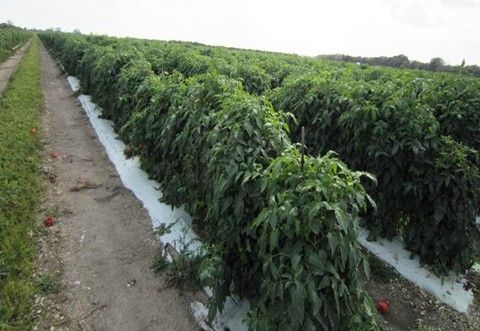
Credit: Qingren Wang, UF/IFAS
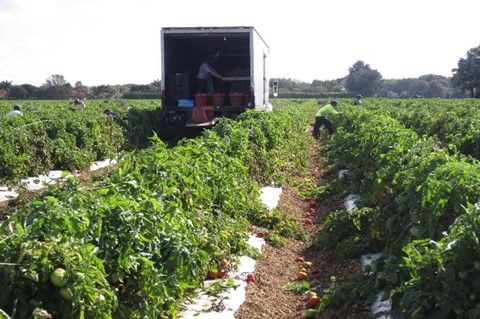
Credit: Qingren Wang, UF/IFAS
Right Placement
The right source and rate of fertilizers must be put in the right place to function effectively. Placement depends on the characteristics of fertilizer, soil type, and water management. For example, P is rarely moveable in soil, and it can be absorbed by soil particles and become plant unavailable, especially in calcareous soils with high pH, such as in south Florida, where abundant calcium has a great affinity to P. However, in north and northwest Florida, the acidic soil, which is rich in iron and aluminum, can also greatly reduce the P availability because binding and precipitation can occur. In addition, an appropriate water management is essential for improving the efficiency of any fertilizers because plants can take up nutrients only when fertilizers are dissolved in water and become a soil solution; however, too much water can cause nutrient loss via leaching and runoff and also make nutrients unavailable to plants.
The basal application of conventional dry fertilizers is usually done on raised beds with single or double strips (Figure 10). When applied as a single strip, the fertilizer is put in the center of the beds, but when applied as double strips, each strip of fertilizer is placed about ½ ft away from the center of the bed. In some cases, the applied fertilizers are incorporated into the soil with slight disking after which the beds are reformed; in other cases, the fertilizers are kept on the surface of the bed, which are covered immediately by plastic mulch (Figure 11). Due to N volatilization and P slow movement and soil fixation, especially in calcareous soils, such as those in south Florida with soil pH as great as 7.8 to 8.2, reducing N volatilization by implementing plastic mulch immediately and two driplines per bed is a practical approach to reducing N volatilization and improving the nutrient efficiency.
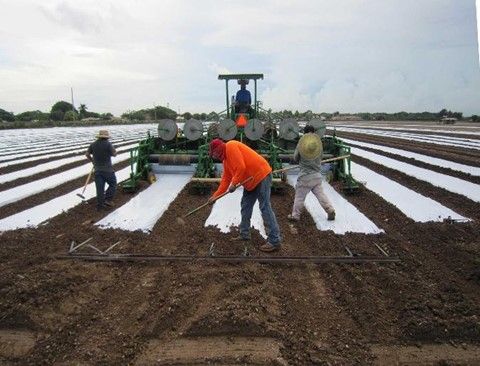
Credit: Qingren Wang, UF/IFAS
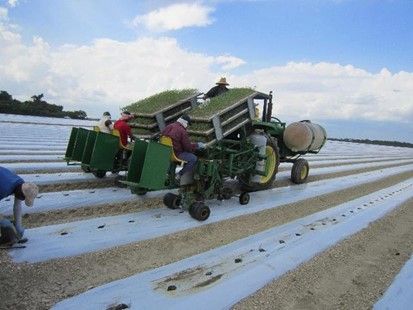
Credit: Qingren Wang, UF/IFAS
With CRFs, fertilizer can be placed either on the surface of beds or can be incorporated into the soil. Plants are able to take up the nutrients released gradually from the coating substances as long as the fertilizer is close to the root zone and appropriate moisture is maintained by the driplines. Because they release nutrients gradually, CRFs usually do not cause fertilizer burn or damage even at relatively high rates.
After 3–4 weeks of fumigation, strong and healthy tomato seedlings are transplanted by hand or with an automatic transplanter (Figure 12). In the latter case, one worker in each row is usually needed to follow the machine to ensure all the seedlings are in the right places.
With fertigation for side dressing, the liquid fertilizer is delivered through driplines (Figure 10) that are close to the tomato plant roots. Therefore, fertigation can provide sufficient nutrients (N and K) and water to tomato root zones and improve the nutrient efficacy.
Conclusion
Nutrient management is a crop- and site-specific. The objective of implementing 4Rs is to optimize the efficacy of fertilizers and to improve crop yield and the sustainability of the agricultural industry. However, all these 4Rs are interrelated. To maximize the productivity and benefit the environment for sustainable development of agriculture, an integrated approach combining all the factors into a single plan is needed to optimize the function and efficacy of fertilizers for Florida tomato production. Tomato growers, consultants, and educators are encouraged to consider all site-specific factors, such as field location, soil types and fertility, tomato target yields, cover crops grown on the site, crop rotation, water management, and horticultural practices. Hopefully, all these parameters will be incorporated, and a real-time application tool with computer or smartphone apps will be available to instruct fertilizer management for tomato or other vegetable growers.
References
Bruulsema, T. W., P. E. Fixen, and G. D. Sulewski, eds. 2013. 4R Plant Nutrition: A Manual for Improving the Management of Plant Nutrition, North American Version. Norcross, GA: International Plant Nutrition Institute.
Florida Department of Agriculture and Consumer Services. 2014. "T-GAP—Tomato Good Agricultural Practices." Accessed June 8, 2022. https://www.fdacs.gov/Agriculture-Industry/Fruit-and-Vegetables/Tomato-Good-Agricultural-Practices-T-GAP
Hochmuth, G., R. Mylavarapu, and E. Hanlon. 2014. The Four Rs of Fertilizer Management. SL411. Gainesville: University of Florida Institute of Food and Agricultural Science. Accessed June 8, 2022. https://edis.ifas.ufl.edu/publication/SS624
Liu, G., K. Morgan, Y. Li, L. Zotarelli, J. DeValerio, and Q. Wang. 2015. What Is 4R Nutrient Stewardship? HS1264. Gainesville: University of Florida Institute of Food and Agricultural Science. Accessed June 8, 2022. https://edis.ifas.ufl.edu/publication/HS1264
Liu, G., L. Zotarelli, Y. Li, D. Dinkins, Q. Wang, and M. Ozores-Hampton. 2014. Controlled-Release and Slow-Release Fertilizers as Nutrient Management Tools. HS1225. Gainesville: University of Florida Institute of Food and Agricultural Science. Accessed June 8, 2022. https://edis.ifas.ufl.edu/publication/HS1225